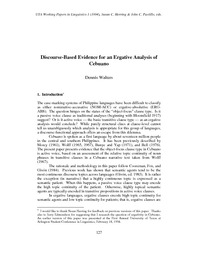
ATTENTION: The works hosted here are being migrated to a new repository that will consolidate resources, improve discoverability, and better show UTA's research impact on the global community. We will update authors as the migration progresses. Please see MavMatrix for more information.
Show simple item record
| dc.contributor.author | Walters, Dennis | |
| dc.date.accessioned | 2008-11-18T23:49:31Z | |
| dc.date.available | 2008-11-18T23:49:31Z | |
| dc.date.issued | 1994 | |
| dc.identifier.citation | Walters, Dennis. 1994. Discourse-based evidence for an ergative analysis of Cebuano. UTA Working Papers in Linguistics 1.127-140. | en_US |
| dc.identifier.uri | http://hdl.handle.net/10106/1191 | |
| dc.description.abstract | **Please note that the full text is embargoed** ABSTRACT: The case-marking systems of Philippine languages have been difficult to classify as either nominative-accusative (NOM-ACC) or ergative-absolutive (ERG-ABS). The question hinges on the status of the “object-focus” clause type. Is it a passive voice clause as traditional analyses (beginning with Bloomfield 1917) suggest? Or is it active voice — the basic transitive clause type — as an ergative analysis would conclude? While purely structural clues at clause-level cannot tell us unambiguously which analysis is appropriate for this group of languages, a discourse-functional approach offers an escape from this dilemma.
Cebuano is spoken as a first language by about seventeen million people in the central and southern Philippines. It has been previously described by Morey (1961), Wolff (1965, 1967), Bunye and Yap (1971), and Bell (1976). The present paper presents evidence that the object-focus clause type in Cebuano is active voice, based on an assessment of the relative topic continuity of noun phrases in transitive clauses in a Cebuano narrative text taken from Wolff (1967). | en_US |
| dc.language.iso | en_US | en_US |
| dc.publisher | Linguistics & TESOL | en_US |
| dc.subject | Cebuano language | en_US |
| dc.subject | Discourse analysis | en_US |
| dc.subject | ergativity | en_US |
| dc.subject | Case-marking | en_US |
| dc.subject | Morphology | en_US |
| dc.subject | Syntax | en_US |
| dc.title | Discourse-based evidence for an ergative analysis of Cebuano | en_US |
| dc.type | Article | en_US |
| dc.type | Working Paper | en_US |
Files in this item
- Name:
- 127-140-d.walters.pdf
- Size:
- 96.01Kb
- Format:
- PDF
This item appears in the following Collection(s)
Show simple item record


